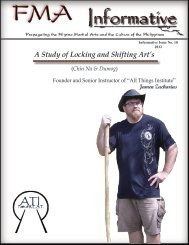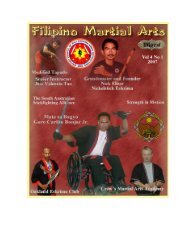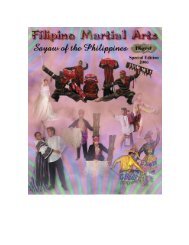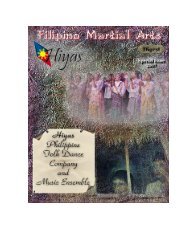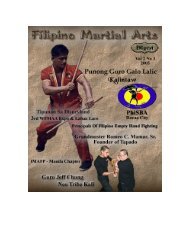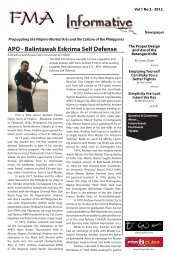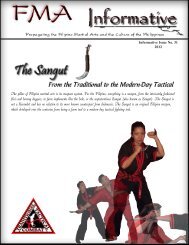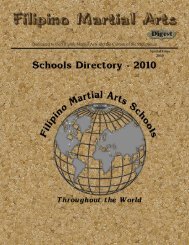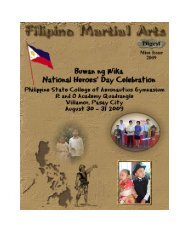Tournaments - FMA Informative
Tournaments - FMA Informative
Tournaments - FMA Informative
Create successful ePaper yourself
Turn your PDF publications into a flip-book with our unique Google optimized e-Paper software.
Since Jaylord is Wilma’s co-worker and Master Dulay’s student it didn’t take<br />
long to ask him to help improve the quality of the Logo. He worked on it during his free<br />
time and after about a week he came up with an excellent <strong>FMA</strong> Logo.<br />
When I first saw the logo after Mr. Padilla had completed his work, I knew I saw<br />
the symbol that would represent the Filipino Culture. It was simple and historically<br />
meaningful.<br />
Today most of the Filipino martial arts organizations use this logo not only as a<br />
symbol of a Filipino martial arts event but as a representation of the whole Filipino<br />
Culture. It is now time to spread it all over the world.<br />
mandirigma.org<br />
This article was brought to our attention by Guro Hospecio "Bud" Balani, Jr. As it turns out both<br />
his father, Hospecio Balbuena Balani, Sr., and his uncle, Martin D. Balbuena, were both<br />
members of the Regiment. He also had numerous uncles in the Regiment but to get their names,<br />
he'd have to dig deep into the darkest recesses of his mind, and it might get ugly in there. From<br />
what he understands, "The United States wanted to be at Regiment strength so they eventually<br />
merged the three Battalions into one unit and formed the 1st Filipino Regiment (keeping the First<br />
Unit's Patch). Regiments are two or more Battalions, Battalions are three or more Companies.<br />
Companies are three or more Platoons. Platoons are three or more Squads. Squads are nine<br />
strong. These are just rough estimates. Also, any unit with the spelling of "Philippines" were US<br />
Army units that were recruited in the homeland. There were many Philippine Scout units, all in<br />
the Philippine islands. Any unit with the spelling of "Filipino", was a unit formed in the United<br />
States, with the only units being Laging Una, Sulong and Bahala Na."<br />
Saturday, August 14th, 2004<br />
The 1st and 2nd Filipino Infantry Regiments<br />
By David T. Vivit, 1LT, AUS (Ret)<br />
Laging Una - Sulung<br />
Part I<br />
The 1st and 2nd (Laging Una - Sulung) Filipino Infantry Regiments were units of<br />
the Army of the United States (AUS) inducted into service during World War II. They<br />
were wholly manned by Filipino citizens in this country and Hawaii and officered by<br />
both Filipinos and Americans, the only non citizen units in the American Citizen Army.<br />
They were similar to the Philippine Scouts in that the latter were also wholly manned by<br />
Filipino citizens with both Filipino and American officers, but the similarities ended<br />
there. The Scouts were professional soldiers in the Philippine Department of the United<br />
States Regular Army (USA). Most of the men were married and enjoyed a high economic<br />
and social status in the Philippines in contrast to the mostly single discriminated against



